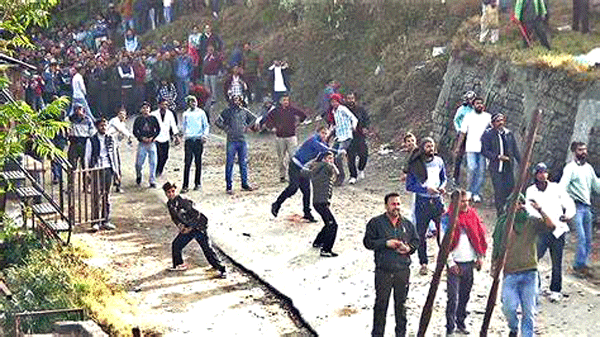Stones, blood, and Bhadrakali’s blessing: ancient stone pelting tradition marks Diwali in Dhami Village
Shimla, Nov 14
Support Independent Journalism Complete Your Membership
Choose Your Membership
A day after Diwali, the Chauraj Village near Dhami in Shimla district hosted its annual stone pelting sacrificial fair, a centuries-old tradition that combines elements of ritual and community fervor. On Monday, the village witnessed another iteration of this unique event, where participants engaged in a symbolic stone-pelting melee in honor of Goddess Bhadrakali.
Unlike the festive atmosphere of events like the tomato festival in Spain, the Chauraj stone-pelting ritual this year, involved two groups hurling stones at each other for approximately 15 minutes. This age-old practice, surviving for nearly two centuries, has transformed into a tradition that is both intriguing and seemingly riotous.
Historically, the stone pelting was preceded by a male sacrifice to Bhadrakali. However, this changed when the queen of Dhami state performed Sati, leading to the cessation of human sacrifices. Subsequently, animal sacrifices were introduced but were eventually discontinued. The stone-pelting fair emerged as a replacement ritual.
The participants hail from two distinct groups—the Tunad, Jathoti, and Katedu families representing the royal side, and the Jamogi family from the opposite end. Stones are thrown from either side at the Sati memorial in Chauraj village until one person sustains an injury. The ritual concludes with the application of Tilak on the platform of Goddess Bhadrakali using the blood of the injured person.
The fair kicks off with the worship of Narasimha from the royal family, setting the stage for the intense but symbolic confrontation that ensues. On Monday, the stone-pelting continued for about 15 minutes until 28-year-old Dalip Thakur from Jamodi village bled after being struck by a stone.
Despite its seemingly archaic nature, the stone pelting sacrificial fair draws considerable attention. Every year, on the second day of Diwali, residents of Dhami and beyond participate in this unique event. Hundreds of people converge on Chauraj village, intrigued by the continuation of a tradition that, despite its apparent disconnect from contemporary norms, persists as a cultural spectacle.
In an age dominated by technological and scientific advancements, the Chauraj stone-pelting sacrificial fair stands as a testament to the enduring power of cultural practices and their ability to captivate communities, both local and from afar.






